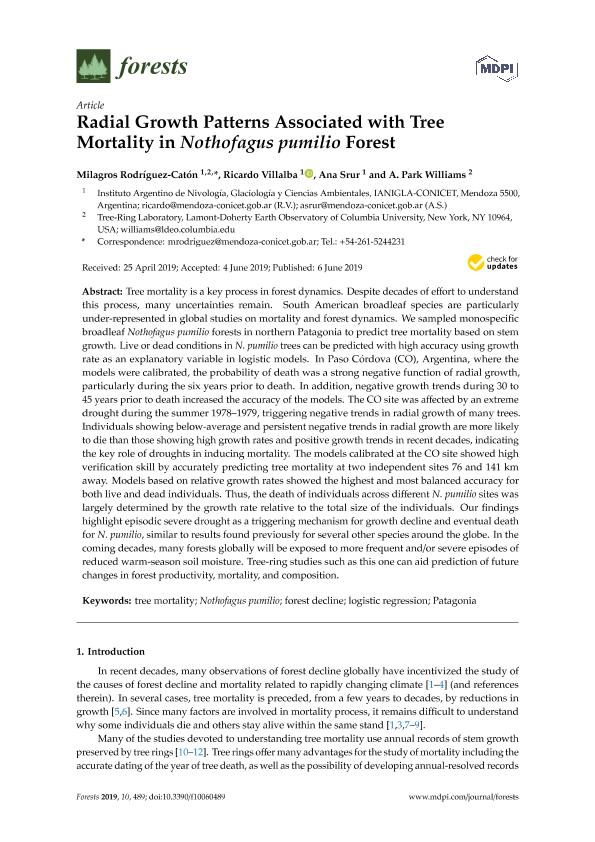Mostrar el registro sencillo del ítem
dc.contributor.author
Rodriguez Catón, Milagros Rocío

dc.contributor.author
Villalba, Ricardo

dc.contributor.author
Srur, Ana Marina

dc.contributor.author
Williams, A. Park
dc.date.available
2021-02-25T19:29:38Z
dc.date.issued
2019-06
dc.identifier.citation
Rodriguez Catón, Milagros Rocío; Villalba, Ricardo; Srur, Ana Marina; Williams, A. Park; Radial growth patterns associated with tree mortality in Nothofagus pumilio forest; Molecular Diversity Preservation International; Forests; 10; 6; 6-2019; 1-18
dc.identifier.issn
1999-4907
dc.identifier.uri
http://hdl.handle.net/11336/126686
dc.description.abstract
Tree mortality is a key process in forest dynamics. Despite decades of effort to understand this process, many uncertainties remain. South American broadleaf species are particularly under-represented in global studies on mortality and forest dynamics. We sampled monospecific broadleaf Nothofagus pumilio forests in northern Patagonia to predict tree mortality based on stem growth. Live or dead conditions in N. pumilio trees can be predicted with high accuracy using growth rate as an explanatory variable in logistic models. In Paso Córdova (CO), Argentina, where the models were calibrated, the probability of death was a strong negative function of radial growth, particularly during the six years prior to death. In addition, negative growth trends during 30 to 45 years prior to death increased the accuracy of the models. The CO site was affected by an extreme drought during the summer 1978-1979, triggering negative trends in radial growth of many trees. Individuals showing below-average and persistent negative trends in radial growth are more likely to die than those showing high growth rates and positive growth trends in recent decades, indicating the key role of droughts in inducing mortality. The models calibrated at the CO site showed high verification skill by accurately predicting tree mortality at two independent sites 76 and 141 km away. Models based on relative growth rates showed the highest and most balanced accuracy for both live and dead individuals. Thus, the death of individuals across different N. pumilio sites was largely determined by the growth rate relative to the total size of the individuals. Our findings highlight episodic severe drought as a triggering mechanism for growth decline and eventual death for N. pumilio, similar to results found previously for several other species around the globe. In the coming decades, many forests globally will be exposed to more frequent and/or severe episodes of reduced warm-season soil moisture. Tree-ring studies such as this one can aid prediction of future changes in forest productivity, mortality, and composition.
dc.format
application/pdf
dc.language.iso
eng
dc.publisher
Molecular Diversity Preservation International

dc.rights
info:eu-repo/semantics/openAccess
dc.rights.uri
https://creativecommons.org/licenses/by-nc-sa/2.5/ar/
dc.subject
FOREST DECLINE
dc.subject
LOGISTIC REGRESSION
dc.subject
NOTHOFAGUS PUMILIO
dc.subject
PATAGONIA
dc.subject
TREE MORTALITY
dc.subject.classification
Silvicultura

dc.subject.classification
Agricultura, Silvicultura y Pesca

dc.subject.classification
CIENCIAS AGRÍCOLAS

dc.title
Radial growth patterns associated with tree mortality in Nothofagus pumilio forest
dc.type
info:eu-repo/semantics/article
dc.type
info:ar-repo/semantics/artículo
dc.type
info:eu-repo/semantics/publishedVersion
dc.date.updated
2020-11-20T17:51:04Z
dc.journal.volume
10
dc.journal.number
6
dc.journal.pagination
1-18
dc.journal.pais
Suiza

dc.journal.ciudad
Basilea
dc.description.fil
Fil: Rodriguez Catón, Milagros Rocío. Consejo Nacional de Investigaciones Científicas y Técnicas. Centro Científico Tecnológico Conicet - Mendoza. Instituto Argentino de Nivología, Glaciología y Ciencias Ambientales. Provincia de Mendoza. Instituto Argentino de Nivología, Glaciología y Ciencias Ambientales. Universidad Nacional de Cuyo. Instituto Argentino de Nivología, Glaciología y Ciencias Ambientales; Argentina. Columbia University; Estados Unidos
dc.description.fil
Fil: Villalba, Ricardo. Consejo Nacional de Investigaciones Científicas y Técnicas. Centro Científico Tecnológico Conicet - Mendoza. Instituto Argentino de Nivología, Glaciología y Ciencias Ambientales. Provincia de Mendoza. Instituto Argentino de Nivología, Glaciología y Ciencias Ambientales. Universidad Nacional de Cuyo. Instituto Argentino de Nivología, Glaciología y Ciencias Ambientales; Argentina
dc.description.fil
Fil: Srur, Ana Marina. Consejo Nacional de Investigaciones Científicas y Técnicas. Centro Científico Tecnológico Conicet - Mendoza. Instituto Argentino de Nivología, Glaciología y Ciencias Ambientales. Provincia de Mendoza. Instituto Argentino de Nivología, Glaciología y Ciencias Ambientales. Universidad Nacional de Cuyo. Instituto Argentino de Nivología, Glaciología y Ciencias Ambientales; Argentina
dc.description.fil
Fil: Williams, A. Park. Columbia University; Estados Unidos
dc.journal.title
Forests
dc.relation.alternativeid
info:eu-repo/semantics/altIdentifier/url/https://www.mdpi.com/1999-4907/10/6/489
dc.relation.alternativeid
info:eu-repo/semantics/altIdentifier/doi/http://dx.doi.org/10.3390/f10060489
Archivos asociados
